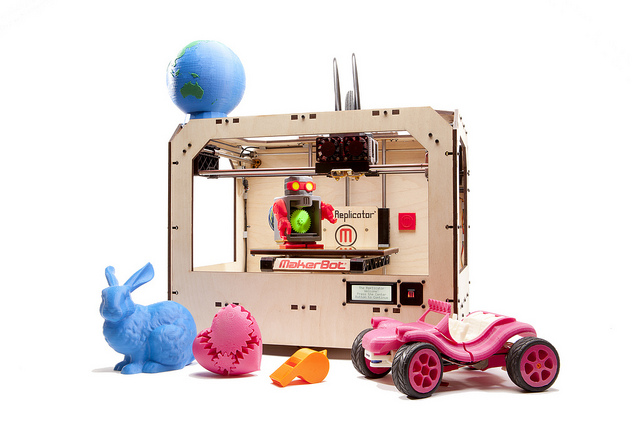· 3D Hardware
· 3D Software
· 3D Video
· 3D TV and Movies
· 3D Art
· 3D Picture of the Day
· 3D Modeling
· 3D Printing
· Reviews
· Gaming
· How To
· News
· Everything Else
· Off Topic
· Around the Web
· Virtual Reality
3D Printing for Dummies
Posted by: Jesse on: 08/17/2012 03:52 PM [ Print |
]
We have all heard of 3D printing (stereolithography) at this point. People these days can make almost anything with it. Planes, shoes, legs, pasta, toys, sand. You name it, you can probably 3D print it. But how does it work? How do people make all these things from a printer?
I’ll explain this in a few easy steps.
First you need a computer with a software design program (Something as complex as CAD or as simple as Doodle3D). You design an object within the program that you would like to print. I want to make a plastic elephant, so I enter all that information into the program, and then send it to my 3D printer (its not a normal inkjet!). The printer will then select the material to construct the object with. Some printers only have one material available, others have many more. After the material has been selected, the layering/printing process begins.

Traditional manufacturing of toy elephants (and many other objects!) requires a process known as subtractive manufacturing. This is the term given to the way people make toy elephants in China, for example. You take a raw material like plastic and you pour it into an elephant shaped mold; or you take a chunk of material and carve away some of it until you have the desired shape. 3D printing is different in that it adds layer upon layer of material with the use of a computer controlled laser or injector kind of spout. Its much more efficient, because there is literally no waste. It can also be extremely fast, and cheap to produce depending on the material you use. The most commonly used material is an ABS plastic similar to Legos.
The possibilities are endless. Jay Leno has used 3D printers to create discontinued automobile parts. The US Department of Defense is capitalizing on the low cost of 3D printing to create specialized aerospace pieces. The medical industry can print medical supplies, synthetic body parts (like jaws), an exoskeleton for a diseased little girl, and real cellular material!
This technology was first patented by Charles Hull in 1986 and in just twenty-six years later we are already offering 3D printers to home users at an astonishingly low price (some printers as cheap as $399 and others as expensive as $50,000 or more). It very easy to buy a 3D printer, there are many available. The most popular is the MakerBot, but there are other options that are smaller and cheaper like the ORD Bot. You can even make your own 3D printer! Who knows, maybe I’ll be printing my own 3D elephants sooner than I think!
I’ll explain this in a few easy steps.
First you need a computer with a software design program (Something as complex as CAD or as simple as Doodle3D). You design an object within the program that you would like to print. I want to make a plastic elephant, so I enter all that information into the program, and then send it to my 3D printer (its not a normal inkjet!). The printer will then select the material to construct the object with. Some printers only have one material available, others have many more. After the material has been selected, the layering/printing process begins.
Traditional manufacturing of toy elephants (and many other objects!) requires a process known as subtractive manufacturing. This is the term given to the way people make toy elephants in China, for example. You take a raw material like plastic and you pour it into an elephant shaped mold; or you take a chunk of material and carve away some of it until you have the desired shape. 3D printing is different in that it adds layer upon layer of material with the use of a computer controlled laser or injector kind of spout. Its much more efficient, because there is literally no waste. It can also be extremely fast, and cheap to produce depending on the material you use. The most commonly used material is an ABS plastic similar to Legos.
The possibilities are endless. Jay Leno has used 3D printers to create discontinued automobile parts. The US Department of Defense is capitalizing on the low cost of 3D printing to create specialized aerospace pieces. The medical industry can print medical supplies, synthetic body parts (like jaws), an exoskeleton for a diseased little girl, and real cellular material!
This technology was first patented by Charles Hull in 1986 and in just twenty-six years later we are already offering 3D printers to home users at an astonishingly low price (some printers as cheap as $399 and others as expensive as $50,000 or more). It very easy to buy a 3D printer, there are many available. The most popular is the MakerBot, but there are other options that are smaller and cheaper like the ORD Bot. You can even make your own 3D printer! Who knows, maybe I’ll be printing my own 3D elephants sooner than I think!
Comments
squs

